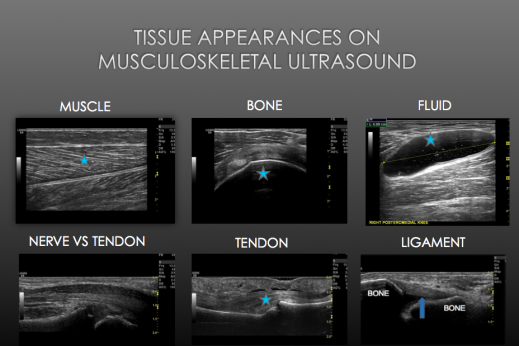Today we are adding something special to the blog. We have reached out to a specialist in the musculoskeletal ultrasound field, Richard Kates, to ask him some questions about his profession, what MSK U/S is and the benefits of it, and advantages over the other common modality for imaging, the MRI.
Q: What is a musculoskeletal ultrasound?
In the simplest version MSK ultrasound is baby-like ultrasound applied to bones and joints. It is the same ultrasound technology used to visualize in 2-dimension babies, since 1958. The technology is way better than then but the same concept since then. A specially trained sonographer will image your joints and soft tissues (tendons, ligaments, blood vessels, nerves, cartilage tissue and other connective tissues) take pictures for documentation and generate a report based upon the images visualized.
 Courtesy of: GrepMed
Courtesy of: GrepMedQ: What are some advantages of using an ultrasound as opposed to an MRI?
Several advantages, time, cost, comfort, length of time to get results, safety, ease of appointment, fears, dynamic exams and reliability. The time to perform the exam about 30 minutes. Cost of a MSK ultrasound is 1/8 the cost of the average MRI. Comfort, patient is usually seated on a comfortable medical chair or exam table with the lights on and no loud banging, clanging, annoying noises. Length of time to get results, results are usually instant same appointment/day results. Appointment times are usually scheduled every 30 minutes and usually available within a 24–48-hour time period. Safety, MSK ultrasounds can be performed on newborns to 100+ year olds without any tissue damage. Can be done over artificial joints, heart stimulators/defibrillators, implanted and external muscle stimulators and any other contraindicators for MRI usage. Since the exam is done in an open room with a treatment table or chair there is little fear from claustrophobia. MSK exams can show dynamic movements and muscles and tendons as they move in real live time views. Reliability is documented in studies at 98% reliability vs MRI with a good MSK technician and physician working in co-operation with the Ultrasound study.
Q: Are there any drawbacks to using an ultrasound?
The main drawbacks to MSK ultrasound are that there is limited diagnostic views in the spine at all levels and that the ultrasound waves do not travel thru bone so structures that are located behind bone cannot be FULLY visualized, ie ACL in the Knee, SLAP lesions in the Shoulder, Intervertebral disks and anything else directly behind bone.
Q: What would an ultrasound examination look like? Does it hurt, is it quick or time consuming? When do you get the results?
An average MSK appointment begins with the MSK tech bringing the patient back to the exam room, taking a complete history of what happened, when, how, where, what was felt, has it changed at all, what makes it feel better/worse before the wand is touched to the skin. The patient will be appropriately clothed shorts, tank top, comfortable clothes. The technician will input your name and information into the ultrasound machine and then begin the examination. Ultrasound gel will be placed on the body part and the wand will be moved across the skin to get the appropriate images. There can be several people in the room or no one else in the room and all are safe to be there. During the examination the patient and technician can have conversations and there will be several dynamic views taken to see the tissues moving in live time, which cannot be done with MRI. Don’t think, don’t blink don’t move for MRI’s. After the exam the gel will be wiped off and the opportunity for the physician and the technician to talk about the results is there. Your doctor may choose to talk to you about your results that moment or wait for 24 hrs to have a report generated. The examination is painless, takes about 30 minutes from start to finish and results are either instant or within 24 hrs.


